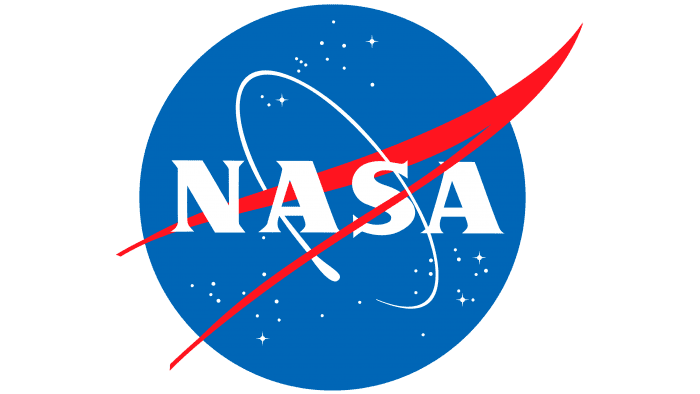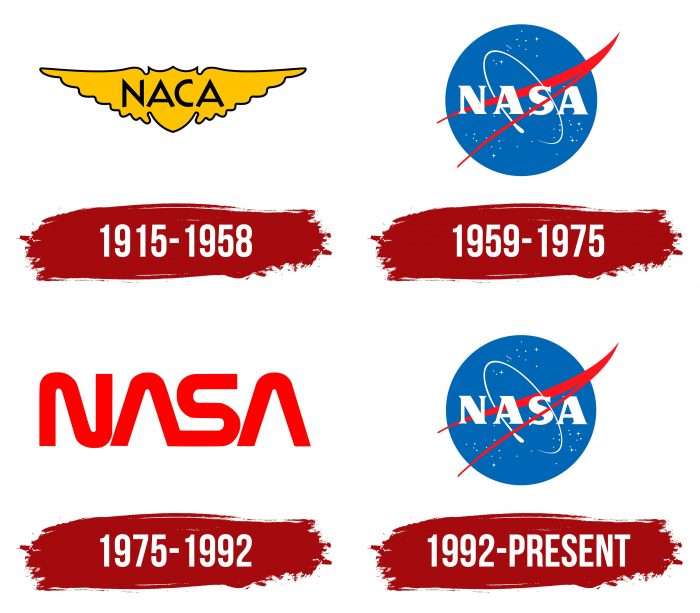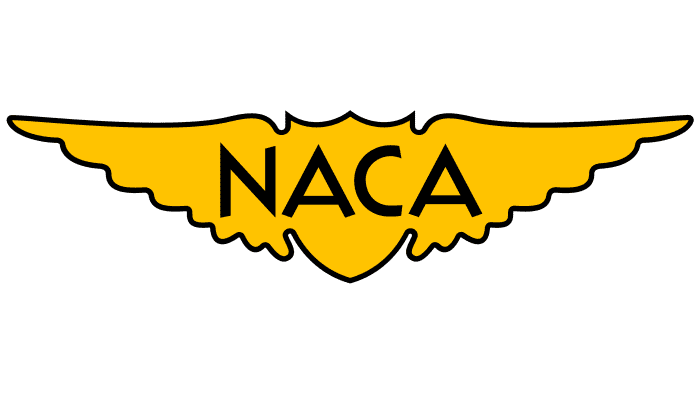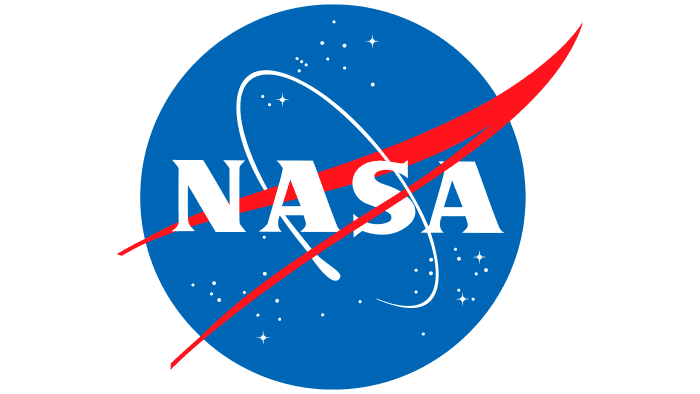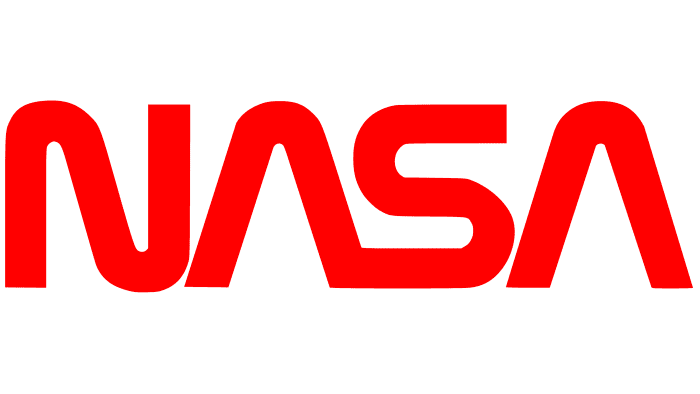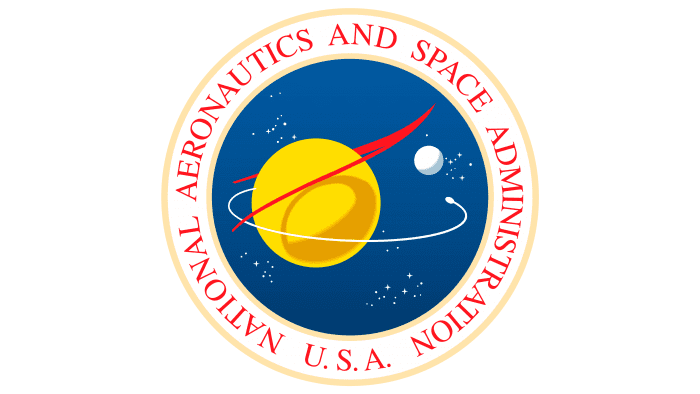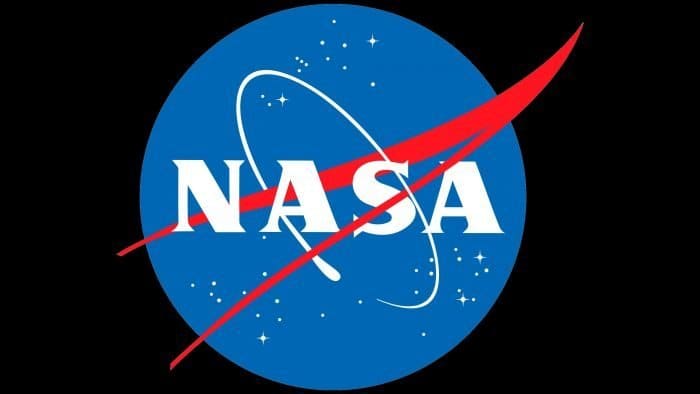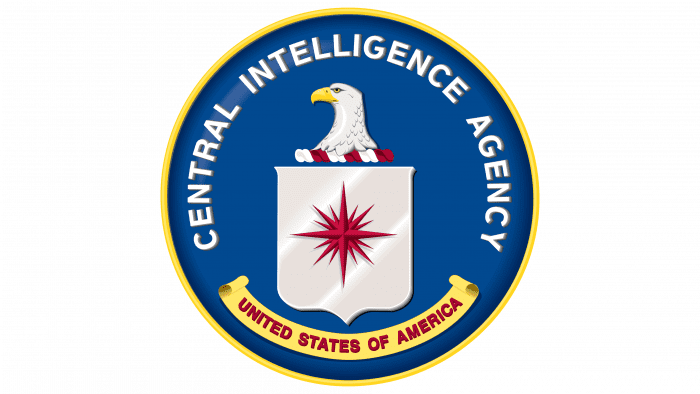The emblem of the National Aeronautics and Space Administration reflects the orientation of the organization’s activities. In all its variations, the NASA emblem is distinguished by its informativeness and recognizability. It represents the Universe and satellite orbit.
NASA: Brand overview
| Founded: | July 29, 1958 |
| Founder: | United States |
| Headquarters: | Washington, D.C., U.S. |
| Website: | nasa.gov |
Meaning and History
One of the most respected organizations in the world has not had many logos. Over the years, the Organization for Aeronautics and the study of outer space has used only three versions. Two of them have a complex structure and are based on the Rondel principle, and one is simple and consists only of the name. James Modarelli, an illustrator at the Lewis Research Center, and the wordmark by Richard Danne and Bruce Blackburn designed the round version. The logo also had a limited number of redesigns – essentially, they were swapped or used in parallel for different tasks.
What is NASA?
NASA is an abbreviation for the National Aeronautics and Space Administration, an agency associated with the U.S. aerospace industry. The organization reports directly to the President and is part of the federal government.
1915 – 1958
The debut logo of the space administration is a stylized heraldic shield with two large spread wings. In the center of the yellow badge is the word “NASA.” It is written in a regular black font – narrow and sans-serif. A dark line runs along the symbol’s contour, which is twice as thin as the letters. This version accurately reflected the tasks of the aerospace center.
1959-1975; 1992 – today
A year after the opening of the space research organization, it got its emblem, representing it at the national level. The amusing name Meatball was given by James Modarelli. This logo was used until 1975, and then, after a long hiatus, it was reverted to. Therefore, since 1992, it has been in use to this day.
The round logo, symbolizing the Universe, depicts a dark blue disk with white dots (presumably stars) intersected by a V-shaped red ribbon. In the center of the rondel is the abbreviated name of the National Aeronautics and Space Administration – “NASA.” A thin improvised orbit with a thickening at one end is located sideways around the word, like the trail of a rocket.
This logo also exists in another incarnation, mainly used for printing and special programs. A wide white frame with a yellow line along the contour surrounds the round blue badge. Around the perimeter is the full name of the agency. The red V-shaped strip, like the white orbit, is arranged around the planet.
1975 – 1992
Richard Danne and Bruce Blackburn created this version. It features the word “NASA,” executed in streamlined red font. Due to the visual similarity of the letters to worms, the emblem was nicknamed “Worm.” It was used as the main logo for over 15 years and was then replaced by the traditional one. Now, this version exists alongside the official one and is used in some projects.
NASA: Interesting Facts
NASA, the National Aeronautics and Space Administration, is a big part of the United States government that works on exploring space and studying everything from airplanes to stars. It started in 1958 because the United States wanted to catch up with the Soviet Union in exploring space.
- Starting Out: NASA was created in 1958 after the Soviet Union sent Sputnik, the first satellite, into space, starting a big race to explore space.
- Walking on the Moon: One of NASA’s biggest accomplishments was sending astronauts to the Moon in 1969. Neil Armstrong was the first person to walk on the Moon, and he said, “That’s one small step for man, one giant leap for mankind.”
- Space Shuttles: From 1981 to 2011, NASA had Space Shuttles that could be used many times to take astronauts and stuff into space. They did important work, like putting the Hubble Space Telescope into space and helping build the International Space Station (ISS).
- International Space Station: NASA works with other countries on the ISS, a big science lab where astronauts experiment to learn more about space and science.
- Rovers on Mars: NASA has sent rovers like Spirit, Opportunity, Curiosity, and Perseverance to Mars. These rovers look around Mars and send back information that helps us understand if there could have been life there.
- Hubble Space Telescope: Since 1990, the Hubble Telescope has been sending back amazing pictures of space, helping scientists learn much about the universe, like how fast it’s expanding.
- Working with Companies: NASA also collaborates with private companies like SpaceX to send astronauts to the ISS and develop new ways to explore space.
- Voyager Probes: The Voyager probes were sent into space in 1977 and are now farther away from Earth than anything else humans have made. They’re sending back information about space far from the Sun.
- Studying Earth: NASA doesn’t just look at space; it also uses satellites to study Earth’s weather, climate change, and natural disasters, helping to keep people safe and learn more about our planet.
- Future Plans: NASA plans to send people back to the Moon and eventually to Mars to learn more about them and maybe even live there someday.
NASA has done a lot to help us understand space and Earth better, and it’s working on even more cool projects for the future.
Font and Colors
NASA uses a special logo resembling a seal for awards, official documents, and special occasions. It is almost a complete copy of the main one and has an additional design. A red line surrounds the blue circle, depicting the Universe on a white background. The full name of the organization – the National Aeronautics and Space Administration of the USA – is written on a wide strip with a beige-pink edge. The central part occupies a yellow sphere, symbolizing the planet. Next to it is the Moon. The satellite’s orbit and the figurative element resembling the letter V surround the Earth.
In 1975, the Space Administration introduced another version of the logo created as part of the Federal Graphics Improvement Program. As a result, the word “NASA” received an “alien” spelling: the crossbar disappeared from the letter “A,” and the letters became streamlined, resembling spaghetti or a worm, hence the informal nickname. This variant was used for 17 years.
The “Worm” emblem has an inscription made in a simple, smooth sans-serif font with clear cuts and rounded corners. Neither letter “A” has a horizontal crossbar. Moreover, the right leg of the central “A” is connected to the beginning of “S.” The Meatball logo has an uppercase font and thin letters with serifs. The palette is tricolor and consists of white, blue Pantone 286, and red Pantone 185.
NASA color codes
| Orioles Orange | Hex color: | #fc3d21 |
|---|---|---|
| RGB: | 252 61 33 | |
| CMYK: | 0 76 87 | |
| Pantone: | PMS 172 C |
| Midnight Blue | Hex color: | #0b3d91 |
|---|---|---|
| RGB: | 11 61 145 | |
| CMYK: | 92 58 0 43 | |
| Pantone: | PMS 661 C |
FAQ
Why is the NASA logo called “worm”?
Worm was the name of the NASA logo in use from 1975 to 1992. It was an inscription whose red-colored letters resembled an earth invertebrate. The authors of this version were designers Bruce Blackburn and Richard Danne.
Did NASA change its logo?
Yes, in 1992, NASA changed its old logo to a worm. Since then, it has consisted of outer space in the form of a blue circle with small stars, a diagonal orbit, a pitchfork-shaped red strip, and the name, typed in bold letters.
Can you use the NASA logo?
NASA does not allow third parties to use the logo. It can only be done by representatives of the administration and the office of the aerospace agency.
What is the official NASA logo?
The official NASA logo is a dark blue disk with a white orbit, a spaceship, a large name, and a red ribbon. It is popularly nicknamed “Meatball”. The developer of this version is James Modarelli.
